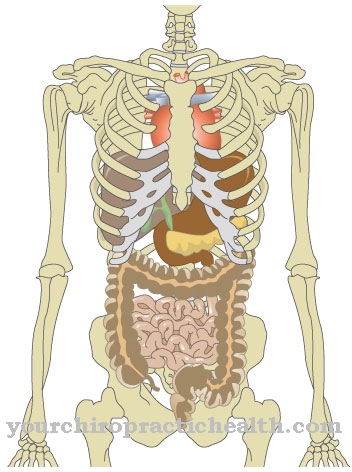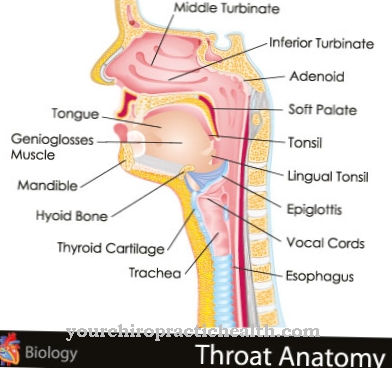The Peroneal palsy caused by mechanical pressure damage to the common peroneal nerve, which carries both motor and sensory nerve fibers of the lower leg. In addition to the stepping gait, the main symptom of paresis are sensory disturbances in the area of the lateral lower leg. The treatment takes place through targeted physiotherapy and protection of the nerves in the knee area.
What is peroneal palsy?

© SciePro - stock.adobe.com
The common fibular nerve - the "common fibula nerve" - is also known as the common peroneal nerve and is a descendant of the sciatic nerve. In addition to somatomotor fibers, the nerve carries general somatosensitive nerve fibers. The nerve path runs medial to the biceps femoris muscle to the head of the fibula and migrates into the fibular cavity, where the nerve divides into the terminal branches of the superficial fibular nerve and the deep fibular nerve.
The common fibular nerve supplies, among other things, some extensors of the lower leg with motor nerve fibers and thus plays an important role in stretching the legs. With the concept of Peroneal palsy lesions of the common fibular nerve are summarized.
Pareses are essentially paralysis of the muscles, as they can be caused by lesions of the motor nerve fibers. In addition to symptoms of paralysis, a lesion on the common fibular nerve can lead to sensory disorders, as the nerve also contains sensitive fibers.
causes
The common peroneal nerve is relatively exposed in the region of the fibular head. For this reason, especially in this area, the nerve is extremely susceptible to damage that can occur as a result of mechanical pressure. Little muscle or fat tissue or rapid weight loss are risk factors for peroneal palsy.
In most cases, however, the cause of the paresis is a fracture of the fibula. A poorly padded lower leg cast can also put pressure on the fibular head and the neighboring common peroneal nerve. In addition, peroneal palsy can occur as part of the compartment syndrome.
Those who have little muscle and fat tissue can cause damage to the nerve tract by crossing their legs for a long time. In individual cases, ganglions, neurinomas, tumors and Baker cysts can also cause peroneal palsy. Common to all of the above-mentioned causes is the mechanical pressure on the exposed nerve tract.
Symptoms, ailments & signs
The common peroneal nerve - the “common calf nerve” - supplies the peroneus longus - the “long fibula muscle” - the peroneus brevis muscle - the “short fibula muscle” -, the tibialis anterior muscle - the “anterior tibial muscle” - and the muscle extensor digitorum longus - the "long toe extensor" - as well as the extensor hallucis longus - the "long big toe extensor" -, the extensor digitorum brevis - the "short toe extensor" - and the extensor hallucis brevis muscle - the "short big toe extensor" - with motor nerve fibers.
The sensitive innervation of the nerve tract plays a role for the lateral lower leg region and the dorsum of the foot. In peroneal palsy, patients suffer from a partial or complete failure of the common peroneal nerve, which usually causes paralysis of the levers of the feet and the levers of the toes.
The main symptom of the clinical picture is therefore a stepping step, whereby the foot can often only be positioned to a small extent. Since the affected nerve also carries sensitive fibers, pressure damage often results in sensory disturbances on the lateral lower leg and in the area of the back of the foot. The severity of the symptoms depends on the extent of the mechanical damage.
Diagnosis & course of disease
At the beginning of the diagnosis there is a thorough anamnesis with a neurological examination. Usually the damaged nerve shows tenderness in the area of the fibular head. This phenomenon is known as Tinel's sign and gives the neurologist the first indications of peroneal palsy. In electroneurography, lead delays are evident.
In the differential diagnosis, the paresis must be differentiated from an L5 syndrome, which would also be associated with pain in the affected area and a weakening of the tibialis posterior reflex. The prognosis is favorable for patients with peroneal palsy. Depending on the extent of the damage, full muscle function can be restored within a few days or months.
Complications
Because of the peroneal palsy, patients primarily suffer from various sensory disorders and disorders of sensitivity. The quality of life of the patient is significantly restricted and reduced due to the disturbances, so that there can be considerable restrictions and complaints in everyday life. As a rule, it cannot be universally predicted whether this will lead to complete healing.
The patients suffer primarily from restricted mobility, so that they may also need the help of other people in their lives. Pain in the knees or legs can also occur due to peroneal palsy and continue to have a negative effect on quality of life. The further course of the peroneal palsy depends very much on the type and origin of the damage to the nerves.
It cannot be universally predicted whether a complete healing will then occur. Treatment for this condition is usually based on the cause. Operative interventions are possible. However, the person affected is also dependent on various therapies in order to increase their mobility again. The life expectancy of the patient is not negatively influenced by the peroneal palsy.
When should you go to the doctor?
Peroneal palsy should always be evaluated by a doctor. If an examination and medical treatment are not carried out, peroneus palsy can lead to irreversible damage and complications that can make life significantly more difficult. A doctor should then be consulted if there is severe pain in the feet and therefore restricted movement. Especially after an accident, a doctor should be consulted if paralysis or pain occurs in the foot or the back of the foot.
The pain can also occur at night, which can lead to sleep problems and irritability. The life expectancy itself is usually not negatively influenced by the peroneal palsy if the accident only affected the foot region. Peroneal palsy can be diagnosed by a sports doctor, an orthopedic surgeon or in a hospital. However, further treatment depends heavily on the extent of the damage, so that a surgical procedure may be necessary.
Treatment & Therapy
Treatment of patients with peroneal palsy depends on the primary cause of the damage. Basic illnesses must be recorded in diagnostics in order to be able to start causal therapy. If, for example, a tumor or a Baker's cyst is responsible for the pressure damage, the growth must be resected as soon as possible.
The earlier the pressure on the muscle is released, the more likely it is that the patient will fully recover. If there is no underlying disease and the pressure damage has occurred due to an accident, physiotherapy is the focus of treatment. Muscle strength is restored in the affected area in targeted physiotherapeutic units.
If the pressure damage to the nerve is extremely pronounced, a peroneal splint can be prescribed. Further pressure damage to the nerve must be urgently avoided. For this reason, patients are advised against kneeling, for example.
Since pressure damage or at least stresses on the common peroneal nerve can arise in the course of certain movements or sports activities, the patient must be informed about permitted and inadmissible types of movement. In principle, protection of the nerve is indicated for the period after the damage so that the nerve tracts can recover from the lesions. Electrostimulation of the damaged pathways can be part of the therapy in individual cases.
You can find your medication here
➔ Medicines for painOutlook & forecast
The further course of a peroneal palsy cannot generally be predicted. This depends very much on how severely the affected person's nerves were damaged and whether they can be repaired again. However, with this disease, an early diagnosis with subsequent treatment always has a very positive effect on the further course of the disease and can also prevent further complications or complaints from occurring. For this reason, the person affected with peroneal palsy should consult a doctor as early as possible and initiate treatment.
If the disease is not treated, the affected nerves can die off completely, causing permanent sensory disturbances or a tingling sensation. These complaints have a very negative effect on the quality of life of the person affected and can significantly reduce it. The symptoms can be alleviated and limited by means of physiotherapy or physiotherapy. However, complete cure is not always possible. In some cases, the symptoms can also be relieved by electrical stimulation. The peroneal palsy does not limit the life expectancy of the person affected. Also, the patient may not be able to regain full muscle strength.
prevention
Peroneal palsy can only be prevented insofar as pressure damage to the common peroneal nerve can be avoided. The nerve is particularly exposed in the knee area. For this reason, kneeling activities and other stresses on the nerve in the knee area should be avoided for the prophylaxis of paresis.
The same goes for crossing your legs. Peroneal palsy cannot be completely ruled out with these preventive measures, but the general risk for the disease can at least be minimized by doing this.
Aftercare
In the case of peroneal palsy, patients usually have very few or no special follow-up measures available. First and foremost, a doctor should be consulted at an early stage so that there is no further worsening of the symptoms or other complications. The earlier a doctor is consulted, the better the further course of the disease will usually be.
Most of those affected are dependent on physical therapy or physiotherapy for this disease. Those affected should also perform the exercises from such a therapy in their own home in order to accelerate healing and to expose the body to low stress. As a rule, the activity that caused the peroneal palsy should be avoided, which can also be a sporting activity.
Those affected should ideally no longer kneel down. Sometimes they depend on the help of other people in everyday life. The disease usually does not reduce the life expectancy of the person affected. Sometimes patients are also dependent on psychological support in order to prevent depression or other psychological upsets.
You can do that yourself
Sufficient protection of the knee is particularly important in patients with peroneal palsy. A strong physical strain on the knee should be avoided as a matter of principle. Sports activities are also to be selected according to the needs of the organism. All sports that contribute to heavy use of the knee should be avoided. They include long-distance runners, athletics and ball sports.
With the first complaints and irregularities of the musculoskeletal system, periods of rest and protection of the knee are essential. Techniques learned in physiotherapy that help relieve the strain on the knee in everyday life should be used independently. In particular, the movement or the carrying and lifting of heavy objects must be optimized.
Since peroneal palsy leads to sensory and sensitivity disorders, it is particularly important to deal with the complaints and discomforts correctly. The use of mental techniques and relaxation methods have proven to be helpful for a large number of those affected. Through yoga or meditation it is possible for patients to better deal with the complaints in everyday life. Cognitive training also helps to reduce stress and to cope better emotionally with the illness.
Since there is no full recovery in some cases, it should be checked whether psychotherapy is used. This helps with the mental change in lifestyle due to the changed circumstances.




.jpg)



















.jpg)



